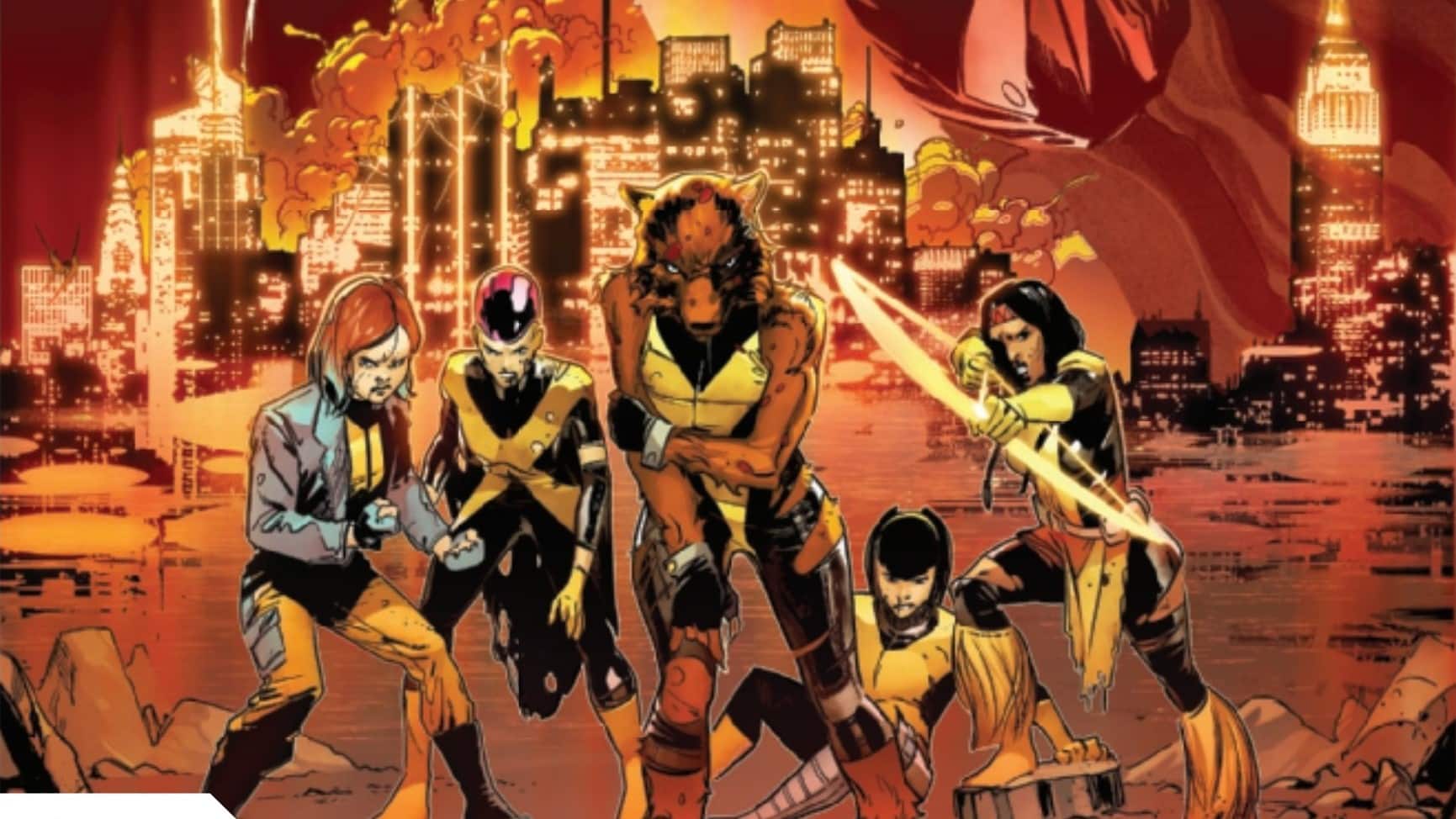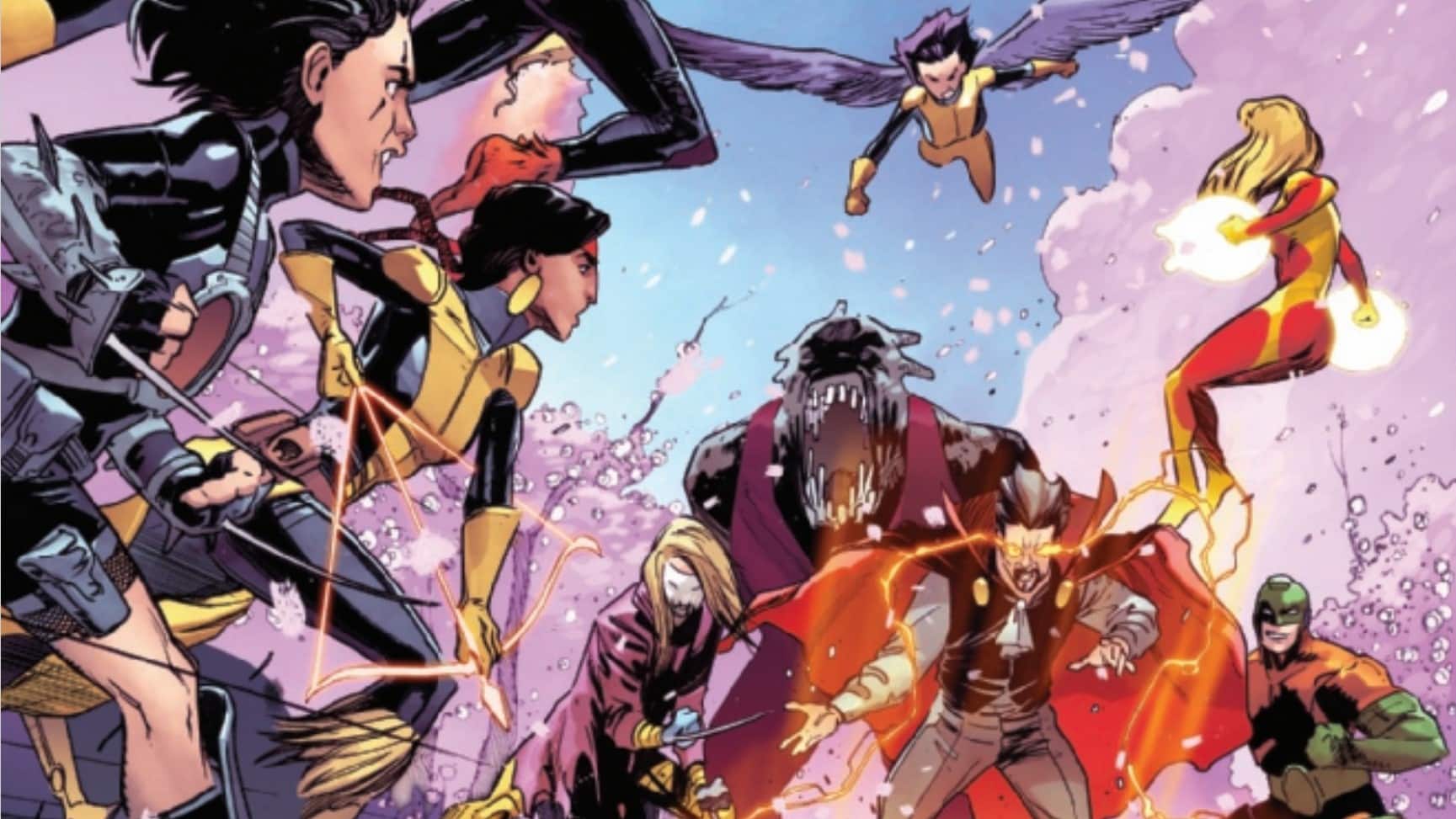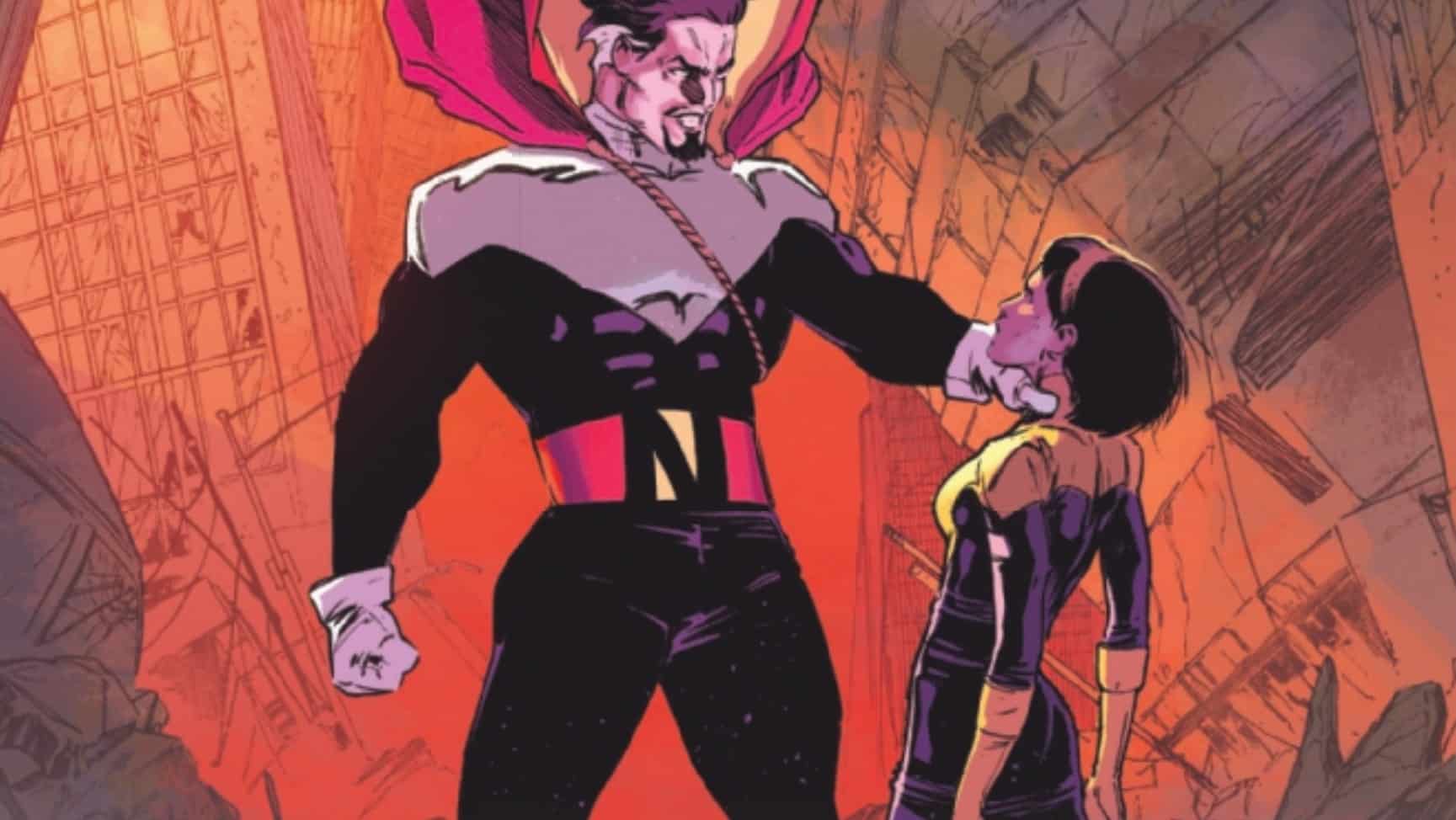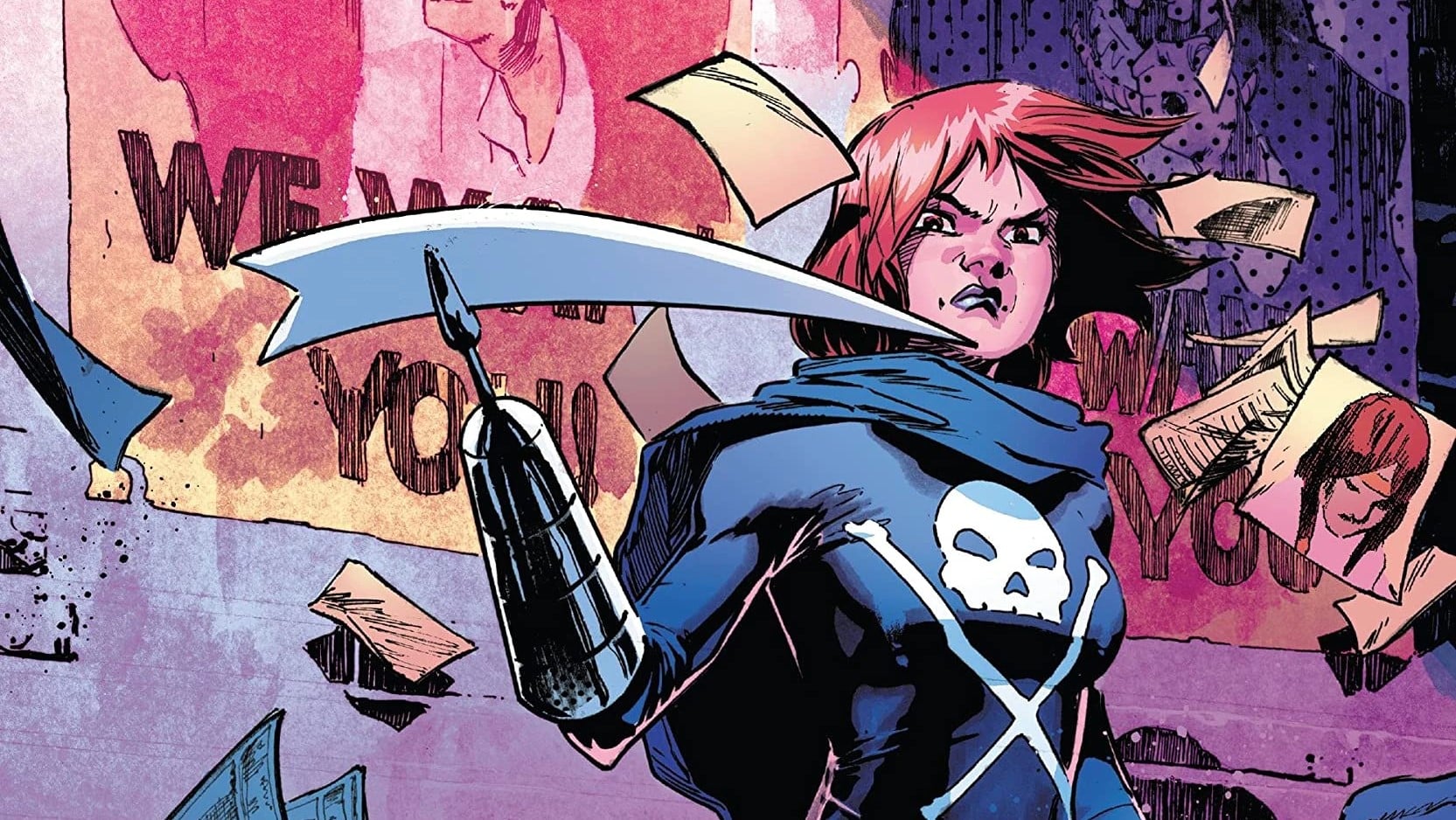Escapade uses her powers to save her friends, but will she be their rescue or their doom? It’s New Mutants #32, written by Charlie Jane Anders, art by Alberto Albuquerque with Ro Stein, Ted Brandt, Carlos Lopez, and Tamra Bonvillain, letters by Travis Lanham.
Liz Large: I wasn’t here for the last issue, but I am back and ready to talk about some New Mutants with you, Steph! I loved everything you had to say about Issue #31, and I’m looking forward to diving in here.
Stephanie Burt: New Mutants, like most things, always go better with friends.
Can I Sleep in Your Brain?

Liz: This issue drops right in as Escapade moves around the U-Men’s base in place of one of their own. I really like the way the art shows the difference between what’s happening (Shela sneaking around the base in her normal outfit) and what her powers are influencing people to see (a regular goon doing goon stuff). If the situation wasn’t so dire, it would be funny – she doesn’t know the words to their chants, isn’t aware of the base coffee etiquette – but there’s a clock ticking as she races to save her friends.
Stephanie: There is. Charlie Jane Anders has saved a lot of the feelings and backstory between Shela and Morgan for the back half of the comic: this part amounts to a chase scene on the Death Star, and I like it. We should probably say what she’s trying to do: having switched bodies with one of the armored U-Men, she’s running around the base searching for Cerebella, a.k.a. Martha Johansen, formerly known as No-Girl, whose telekinetic, telepathic super-brain John Sublime ripped out of her body and used to empower his evil cult way back in the Morrison run. And now, having captured Martha, Mr. Sublime (who is, by the way, a billion-year-old super-virus in tight pants and a necktie) wants to do it again.
Liz: This is a lot of pressure for her first outing with the X-Men! Shela seems great at causing mayhem, though, everything from disabling guns to mixing up a bunch of wiring in a way that does NOT look safe. How do you think she’s holding up under the pressure?
Stephanie: Badly, Liz. Badly. Anders’ writing, on the other hand, holds up really well: she’s a novelist (a terrific one) and she’s pretty wordy for a writer of modern decompressed comics. She’s also using interior monologue, which I’ve been warned against (“let the pictures tell the story,” etc). We read Shela’s thoughts, in neat orange boxes, as she makes her way through the bad guys’ base. And yet it all works, at least for me. Rereading I caught the asides, the nods to real-world bigotry, and the jokes at the U-Men’s expense: “Mutants don’t feel pain like we do,” one remarks. Another eats eggshells, practicing “metonymic gastronomy,” which I can imagine would-be Musks and fashion-forward techbros adopting IRL. Plus the U-Men have minted their own (crypto) currency.
Liz: I’m sure the fact that Cerebella is the person in the most danger isn’t helping, since Shela and her are so close. Poor Martha just can’t catch a break! She finally gets a body, and a new friend to go dancing with, only to have the nightmare of her past come back to haunt her.
Stephanie: Also, trans allegory much? Basically everything Cerebella says all issue has that extra layer on top, like pink-blue-white icing on a delicious adventure story cake. “I waited so long to have a body and now these jerks want to seize power by taking my body away from me.”
Liz: The rest of the team isn’t having an easy time of it either, trapped in a power-dampening cage with a very confused and upset goon that Shela has swapped with. Morgan isn’t even living on Krakoa — this is very much not his problem, and he doesn’t even like the X-Men and affiliates.
Stephanie: He does not. He does like his bow tie though. Liz, what do you think about Albuquerque’s art this time out? It’s dynamic and expressive but the ink lines look too dark and thick around the people, like iron in stained glass. Also Morgan’s skin looks so much lighter in the present-tense panels, colored by Carlos Lopez, than his skin does in the flashbacks, colored by Tamra Bonvillain. I know some people’s skin color really does change as they get older, but this change looks jarring, and maybe not fully intended.
Liz: I agree— I know different styles look different ways, but I’m not in love with the line work here. Issues with coloring consistency are always ongoing with comics, but it’s something an editor should keep in mind (since there have been more serious issues in other books in the past).
I Can Change, I Can Change, I Can Change

Liz: Cerebella is trapped, and Shela’s unable to free her in the limited time she has. Cerebella begs for Shela to kill her quickly, since she’ll be resurrected without any memory of today’s traumatizing (or retraumatizing) events, and Sublime won’t get the chance to use her for his evil purposes. Shela can’t do it, and I can’t necessarily say I blame her! It’s probably the tactically correct choice, but that’s a big, scary thing to commit to when you joined a superhero team ten minutes ago!
Stephanie: It’s such a great only-in-X-comics dramatic moment. I, who have been reading since the Krakoan era began, who have seen dozens of mutants– including the one in whom I see myself most often– come back to life on page, agree completely with Martha’s proposal: kill her and she’ll come back and things will be fine. But I’m not Shela, who has (so far as we know) never killed anyone. And I’m not the one who has to pull the trigger, or wield the knife, or do whatever it takes to kill the body of my new friend, who just got her body back, who’s lying in front of me.
Liz: At the same time, I can completely understand Martha’s anger with Shela. Martha’s the one with the most experience here, both as a superhero and with Sublime specifically, and she knows exactly what she’s in for if she doesn’t get out of here as soon as possible. She’s asking Shela to save her from all of her worst fears, by doing something that won’t hurt anyone except herself. What do you think?
Stephanie: See above. Martha’s absolutely correct, and Scott would kill her without a second thought. Captain Pryde would also kill her, with a second thought. Ororo would try to find a different way. And Charlie Jane Anders has found, as they say on that TV show with the guy in the helmet, The Way: place characters we like in situations where those characters make dramatic, difficult, sometimes foolish decisions, even when we know better than they do.
Liz: Martha is so brave here. Sure, she’s strapped to a table with no clear way out, but that’s not going to stop her from telling Sublime exactly how much she hates him.
Stephanie: “You’re just bacteria. You’re E. coli with good hair.” I love it. John Sublime is just so awful. He represents power, diffused throughout a society in a way that makes inequality worse, a power that doesn’t care who gets hurt because it’s not localized in a person. But he also reminds me of Peter Thiel and his ilk: posthumanist Richie Rich types who believe they’re entitled to take whatever they want, because they and theirs are The Future. Same dudes who want to control online social media, so that we can’t say, in public, what we really think: “You tried to take everything away from me,” Martha tells Sublime, “even my opinions.”
Liz: And so, Shela makes a dangerous sacrifice to save her brave friend. She’s not willing to hurt or kill Martha, but she’s got no such concern for herself, doing a dangerous second swap (something she’s never done before!) and putting herself in the place of Martha on the operating table, moments before Sublime starts his work. It’s a gesture of bravery and devotion! I also think it’s a gesture of misplaced guilt, for the murder-yet-to-come of Morgan. What do you think about this plan?
Stephanie: I think you’re right, and I think it’s a good plan B. I also think it’s the one place where this comic book could have explained itself better. Shela switches bodies with Cerebella, placing Cerebella’s consciousness in the body of the U-Man at her side, while the U-Man’s consciousness switches to Shela’s own body, which remains in a holding cell with Rahne and Morgan, right? I’m pretty sure that’s right. But it took me a moment to figure out.
Liz: While Shela is endangering herself, the other New Mutants need to fight their way out. While Rahne is definitely not who we’re meant to be focused on in this issue (as one of the adults the kids are rebelling against), I cannot imagine the stress she’s under right now. She took these kids, including those with no real heroing experience, to a fun public event, they immediately got kidnapped, and now the shit has hit the fan and she needs to get them all out with no backup.
Stephanie: She can do it! I believe in her! I also believe she’s developed a pretty bad case of Supporting Character Syndrome: here and in Vita Ayala’s last, Illyana-centric arc and in the Shadow King/ Wild Hunt arc and going all the way back to the Hickman and Brisson stories, Rahne keeps showing up in New Mutants books but never gets to inhabit the A-plot. Justice for Wolfsbane?
Point Me Toward the Real

Stephanie: Before we get to the climactic moment I would like to take this paragraph to yell about Cerebella’s handwritten letter, answering what appear to be standard questions that the adult teachers ask the teen mutants. Cerebella asks the adults, in effect, “Where the hell were you all these years when you allowed me to be a brain in a jar? Did you think that was really what I wanted?” Unfair, perhaps– it’s not like the pre-Krakoan X-Men had the power to manufacture bodies!– but you can see how she feels. She’s, also, every trans teen who figures out how to ask for help, and realizes what’s wrong; fair or unfair, she or he or they or ze might well look back on her unhappy childhood self and ask the adults “Where were you???”
Liz: One standout in this issue is the friendship between Shela and Morgan. The little flashbacks we get of their childhood, in a Peanuts-esque style, are so sweet and sad. They were there for each other through the tough times, and I really like getting to see their super-villain origin story here.
Stephanie: Super-villain in scare quotes, because they don’t actually want to do anything evil: they just want to live inside a giant robot with death-ray eyes, presumably because they’ve watched way too many mecha anime. Or maybe they’ve watched just enough. The Peanuts bits also establish how deep Morgan’s distrust of superheroes goes. What have they ever done for him?
Liz: Morgan’s email to Shela is also pretty great. They seem like they have such an open and honest friendship — Shela went off to be on Krakoa because she’s afraid of the vision where she causes his death, but she TOLD HIM ABOUT IT! That’s how you know she’s not going to fit in with some of the more old-timer mutants: she actually shares information with the people who may be affected, even if it hurts them.
Stephanie: She even knows how to use a phone. And she tries so hard to be there for her friend. That’s how she fits in so well with the older New Mutants, or at least how she will, if she sticks around: she understands that trustworthy interdependence, not total independence, makes the best life goal. “We look after each other when it counts,” as Cerebella says (while we see Shela crying).
Liz: Morgan’s email raises some good points, actually. I think there’s a lot of other things that could be depicted in a vision of what looks like someone falling to their death, and a lot of ways that avoiding that that could actually cause it. Do we believe that this vision is true, and accurate?
Stephanie: I believe it’s literally true: there’s a fall, and a body swap, and we’ll see them both next issue. Will Morgan die? Maybe not. Or maybe he will and then he’ll get resurrected on Krakoa, since the mutant industrial complex already has his engram and his DNA. Honestly I suspect that’s the big final twist– especially since, of all the sympathetic mutants we’ve met lately, Morgan’s the one who distrusts Krakoa and dislikes the X-Men most. Imagine him waking up there and realizing they’ve saved him.
Liz: And of course, this last page is the realization of all Shela’s fears. This is the scene of the horrible future where she kills her best friend. This is what she’s been running from this whole time.
X-Traneous Thoughts
- We haven’t talked about Leonora (Leo) Eng, the telekinetic, telepathic mutant who just happened to get captured along with Rahne, Morgan, Shela and Martha: did you know she first appeared in Prisoner X? Or that she’s trans? Every single mutant in this story is either literally or allegorically trans: neat.
- Alberto Albuquerque excels at drawing scary, sterile technology, from the U-Men’s mono-red-lens uniform to the “weird pipes that look like bendy straws” on the last page.
- The U-Men keep life-size pop-ups of A-list X-Men, presumably for target practice: Kurt with a cutlass, Magik with her Soulsword. They’ve got the same love-hate-group relationship with mutants that real-life hate groups often seem to have with the groups they attack: they just can’t stop thinking about them.
- We still can’t get over how cute the flashbacks are! Flashback artists Ro Stein, Ted Brandt, and Tamra Bonvillain, please take a bow.







